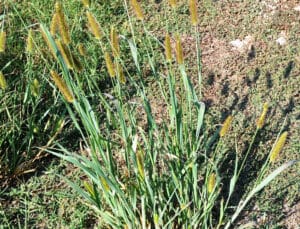Description
Brooms are a group of shrubs that were introduced into North America from Europe and North Africa in the mid-1800s. Brooms can be found growing along roadsides, forestlands, coastlines, riparian areas, brushlands, and disturbed areas. These highly competitive shrubs grow rapidly and form dense stands that both people and wildlife find impenetrable. Their dense stems make regeneration of most other plant species difficult or impossible, and they create a dangerous fire hazard.
In addition, as legumes, brooms can fix atmospheric nitrogen, increasing soil fertility and giving a competitive advantage to other non-native weeds that, unlike the local natives, thrive on high nitrogen levels.
The four most common broom species are Scotch broom (Cytisus scoparius), French broom (Genista monspessulana), Spanish broom (Spartium junceum), and
Portuguese broom (Cytisus striatus).
Cultural Control
The two primary methods for managing brooms are mechanical removal and treatment with herbicides (weed killers). Broom establishment is through seed dispersal, so maintaining a healthy cover of desirable vegetation and reducing soil disturbance may reduce the potential for broom invasion.
Ongoing monitoring for new seedlings is crucial for successful management. Mechanical Control Small infestations can be removed by hand-pulling or mechanical grubbing. A variety of tools can aid in removal, including shovels or picks, chains, or specialized tools such as the Brush Grubber or The Uprooter. It is easiest to remove plants in early spring or late fall when the soil is moist and roots can be dislodged. Grubbing when the soil is dry and hard usually will break off the stems, leaving rootstalks that may resprout. Fortunately, with brooms, fragments of stems do not survive to produce new roots as in some weedy species. Mowing broom plants gives poor control unless performed repeatedly throughout the growing season.
Within a couple months of germination, young plants usually have produced underground rootstocks large enough to recover from a single mowing. Use extreme caution when mowing during spring and summer because of the potential for wildfires.
Mowing later in the season also can spread seeds. Lopping mature plants near the base will provide some control if done when plants are moisture-stressed in late summer, or in late spring following a winter with little rainfall. Lopping at other times can lead to vigorous resprouting. Under most conditions, brush rakes and bulldozers that leave pieces of rootstocks behind do not provide successful control. In some cases, brush removal in late summer, when plants experience moisture stress, can slow their ability to recover.
However, using large equipment to clear land may also promote seedling establishment, making follow-up control essential.





